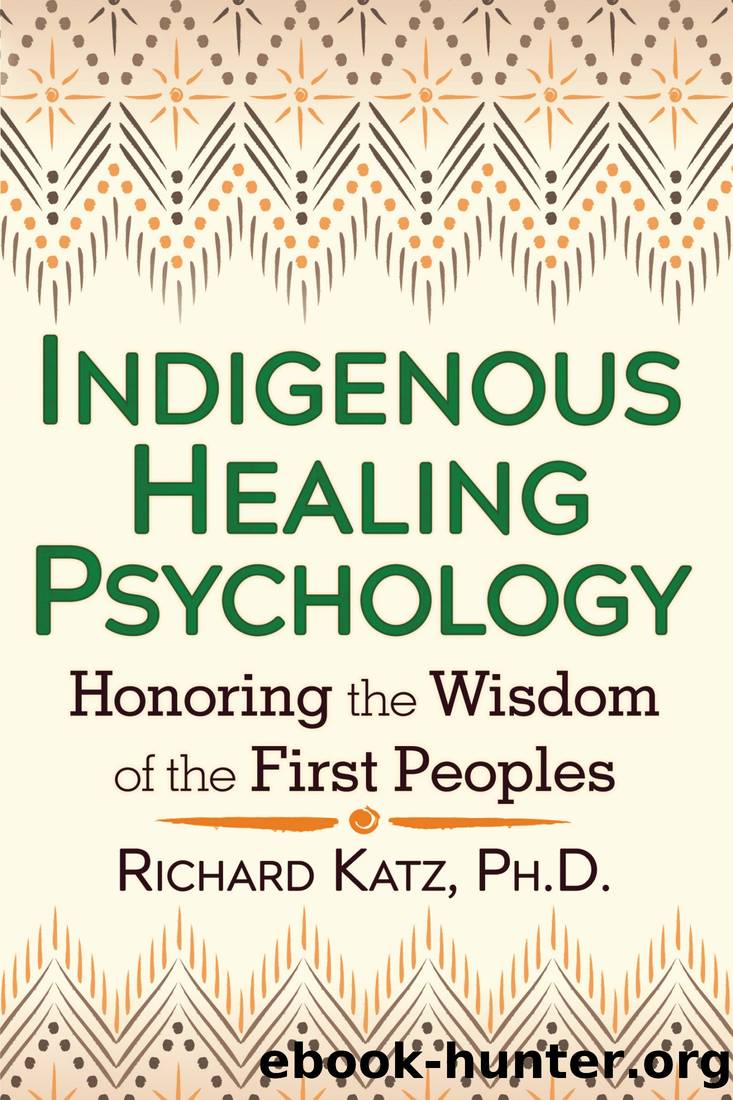Indigenous Healing Psychology: Honoring the Wisdom of the First Peoples by Richard Katz

Author:Richard Katz [Katz, Richard]
Language: eng
Format: epub
Tags: healing, Prayer & Spiritual, Social Science, Spirituality/Psychology, Psychology, Ethnopsychology, Cultural & Social, BODY; MIND & SPIRIT, anthropology
ISBN: 9781620552681
Google: 0l8oDwAAQBAJ
Publisher: Simon and Schuster
Published: 2017-12-19T23:39:05.567520+00:00
INDIGENOUS APPROACHES
The light of near dawn warmly illuminates the Ju/âhoan healing dance at /Kae/kae. The dance is winding down, as people slowly stretch, soon to enter the rest of sleep. Itâs been hard work, hard but joyful. Lots of powerful healing, lots of good visiting, lots of unbridled laughter. And =Oma Djo, now sitting next to me, has not held back the last few hours, dancing gently, and then fiercely, healing all, his sweat reflecting the glowing fire in the middle. âHealing makes our hearts happy,â he tells me.*268
=Oma Djo is filled with joy; he is more than happyâhis heart is happy. And this means heâs glad heâs able to serve the people, to help bring healing to those at the dance. It means he feels connected to, at one with his community, as during that healing, with its intimate laying on of hands, there is a deep and respectful exchange of healing between him and others. Since the source of healing comes from beyond him, from beyond the community, itâs inexhaustible. =Oma Djo releases that healing energy, leaving aside ego concerns that could bottle it up. He knows that as he heals one, he makes it more likely someone else will heal another, as the boiling n/om moves from person to person through exchanges and connections. As =Oma Djo brings healing to others, others support and feed the intensity of that healing energy, that boiling n/om. The differing rhythms and intensities of the womenâs singing has helped him balance the heat of the boiling n/om with the task of healing, so he could heal rather than being overwhelmed by the searing pain of the boiling energy within.
Inevitably, the healing established at the dance is challenged and diminished by the obstacles and textures of daily life. Healing is not a once and done phenomenonânor easily marked by the removal of symptomsâbut a continual negotiation, a back and forth between the balance established by healing and the existential imbalance that is part of the flow of daily life. Long-standing conflicts reemerge: perhaps a person who so intimately helped =Oma Djo during the dance now complains about =Oma Djoâs perceived failure to share the meat that came to his house. And new ones can develop. Eventually, the community feels a need for healing as imbalance weighs more and more heavily over balance. Healing communities are constantly re-created and recreating communities.
How could mainstream psychology possibly measure, even understand, what =Oma Djo has just experienced and affirmed? Healing as balance is so dynamic, constantly being worked and reworked; healing as exchange is so filled with interconnections, continually reciprocating its effects; and healing as a renewable and expanding phenomenon is so expressive of a source beyond the restrictions of ego-bounded concerns like taking personal credit for outcomes. For the Ju/âhoansi, the source of healing is the gods and the boiling n/om, but there are many names for the beyondâwhich is why Indigenous approaches to health and healing are so richly promising, pointing toward potential rather than just removing obstacles.
Download
This site does not store any files on its server. We only index and link to content provided by other sites. Please contact the content providers to delete copyright contents if any and email us, we'll remove relevant links or contents immediately.
Machine Learning at Scale with H2O by Gregory Keys | David Whiting(4179)
Never by Ken Follett(3790)
Fairy Tale by Stephen King(3220)
The Man Who Died Twice by Richard Osman(2997)
Reminders of Him: A Novel by Colleen Hoover(2951)
Will by Will Smith(2792)
Rationality by Steven Pinker(2291)
Can't Hurt Me: Master Your Mind and Defy the Odds - Clean Edition by David Goggins(2227)
It Starts With Us (It Ends with Us #2) by Colleen Hoover(2198)
Friends, Lovers, and the Big Terrible Thing by Matthew Perry(2119)
The Becoming by Nora Roberts(2087)
The Stranger in the Lifeboat by Mitch Albom(2050)
Love on the Brain by Ali Hazelwood(1965)
New Morning Mercies: A Daily Gospel Devotional by Paul David Tripp(1876)
The Strength In Our Scars by Bianca Sparacino(1776)
HBR's 10 Must Reads 2022 by Harvard Business Review(1776)
A Short History of War by Jeremy Black(1762)
Never Finished: Unshackle Your Mind and Win the War Within by David Goggins(1641)
515945210 by Unknown(1599)
